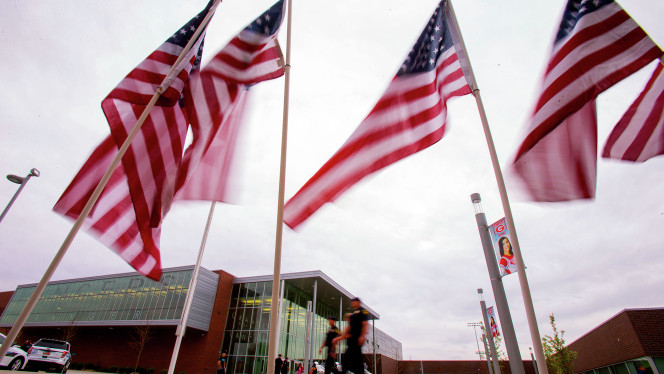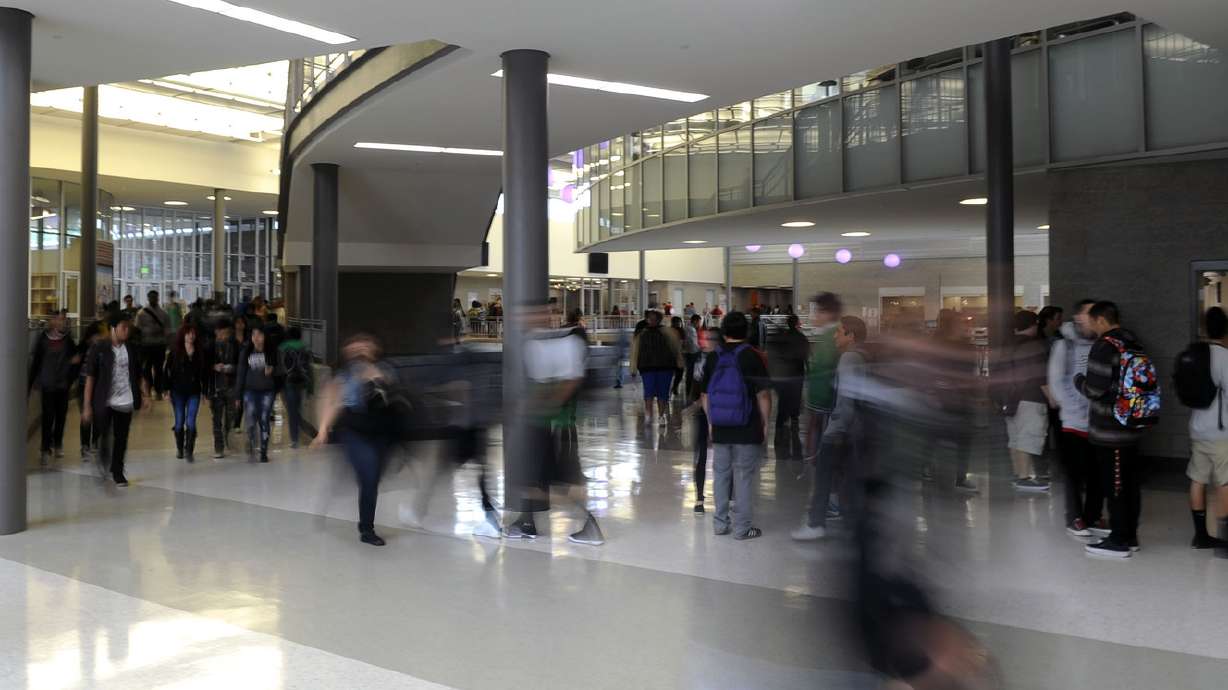Estimated read time: 7-8 minutes
This archived news story is available only for your personal, non-commercial use. Information in the story may be outdated or superseded by additional information. Reading or replaying the story in its archived form does not constitute a republication of the story.
SALT LAKE CITY — Craig Stauffer has his work cut out for him.
While most schools quietly await the return of familiar faces and the start of another ordinary school year, Hunter High School, where Stauffer serves as principal, is anything but quiet.
This fall, ninth-graders will join the ranks in what has been a campus for 10th- through 12th-graders. The West Valley high school is expected to take on 700 new students, which will boost the school's enrollment by 34 percent and make it the second-largest school in the Granite School District.
But for that to happen, Hunter will need the equivalent of 14 more classrooms, not to mention the upgrades that normally happen in a school over the summer. Stauffer has also hired 32 new teachers, 22 of whom are coming to Hunter as part of the new 9-12 configuration.
It's no small transformation to take on in the course of a summer.
"Our August is going to be very, very busy," Stauffer said. "The biggest thing this summer for me to do is to make sure that the school's ready to go with all of the new construction completed so that we're ready to begin the new school year."
Hunter High School isn't alone in transforming the way it serves students. The Granite Board of Education is currently considering proposals to change Cottonwood and Cyprus high schools into 9-12 schools, a model unlike most schools in the Wasatch Front that include only 10th- through 12th-graders.
By 2016, more than half of Granite School District's high schools could be four-year schools. That transition poses logistical challenges for school and district leaders, but that task, they say, is worth the academic rewards that students get in return.
Since switching to a four-year model two years ago, Granger High School has increased the number of ninth-graders on track for graduation by as much as 20 percent, according to Granite spokesman Ben Horsley.
"It's known as a better pedagogical model," Horsley said.
The board is expected to vote on the proposed changes for Cyprus and Cottonwood in its July 7 meeting. If approved, the changes would take effect in the 2016-17 school year.
Balancing logistics
While not entirely unique to Utah, 10-12 high schools are in the minority throughout the country, where about 80 percent use the 9-12 model. Horsley said a population boom in Utah from the 1980s up until the Great Recession has forced some schools to reconfigure their grade structure, keeping ninth-graders in junior high schools.
"The only reason that we're using the current model that we have had for the last 20 or 30 years in some of these schools is because of population, not because of what we thought was best academically for the kids," he said.
The only reason that we're using the current model that we have had for the last 20 or 30 years in some of these schools is because of population, not because of what we thought was best academically for the kids.
–Granite School District spokesman Ben Horsley
Prior to the official proposals to the board for Cyprus and Cottonwood, neighborhood surveys found 67 percent of parents in the Cyprus network support changing to a 9-12 model, as well as 62 percent of parents favoring the change at Cottonwood. Roughly 1 in 4 parents were opposed in both areas, according to Horsley.
Horsley said parental support was the main catalyst for the change, but steady or declining student populations in recent years have also allowed district leaders to make the change. Overall, the district's enrollment decreased by 743 students between 2008 and 2014.
Stauffer said he's confident that this summer's renovations will be enough to keep the class sizes close to what they have been, usually between 30 and 33 kids per class. But it's unclear how crowding will change outside the classroom, he said.
"As far as students in classes, it's not going to be tight at all," he said. "But our inside structure, the actual hallways, none of that is going to change. So that will be an interesting thing to see what ends up happening. That and lunches, and, of course, assemblies."
Hunter High School's transformation certainly isn't a first for Granite. Granger High School made the switch in 2013, and enrollment there increased by almost 70 percent, or 1,185 students, 828 of whom were ninth-graders, according to the Utah State Office of Education.
Kearns High School adopted the change last year, taking on an additional 755 students, 701 of whom were freshmen, boosting the school's headcount by 49 percent from the year before.
If approved by the board, Cyprus will take on more than 300 additional students, and Cottonwood will receive between 400 and 500 more students. Horsley said the district is planning to make boundary changes for the two schools to help accommodate the change without major capital overhauls. But down the road, new facilities may be needed.
"I think long term, we are looking at making some of those types of solutions, but at this point in time, some boundary changes and logistical changes should more than suffice," he said.
The Salt Lake City and Canyons school districts also use a 9-12 model for high schools. Canyons transitioned all of its high schools in 2013 as part of a strategic academic plan that began shortly after the district was formed.
Canyons spokeswoman Jennifer Toomer-Cook said the change required boundary adjustments for 45 schools, as well as several years of preparation. But implementing the new policy over the course of several years and involving parents helped the transition run smoothly, she said.
"It was a massive change all at once, systemwide," Toomer-Cook said. "It required some recertification of our staff and different placement of staff. It required communication to all of our parents and working with our communities … about what kinds of things kids can expect and how we are going to meet the needs of students in different settings than they were used to."
Currently, Davis, Jordan and Alpine school districts all have three-year high schools, and no major discussions have begun to move to a four-year model, according to district representatives.

Scott G. Winterton/Deseret News
Academic outcomes
Horsley said educators are already seeing academic improvements attributable, at least in part, to the four-year model. Prior to making the switch in 2013, Granger High School had a graduation rate of 64 percent, but that rate has since increased by 10 percent. The school's percentage of freshmen on track to graduate has also gone up, despite an enrollment increase of 1,200 students in two years.
"In Granger, we saw tremendous results because of 9-12," he said.
Kearns High School also increased its graduation rate by 5 percent since becoming a four-year school.
Aaron Wilson is an assistant principal at Granite Park Junior High School who studied 9-12 high school configurations as part of graduate research at Southern Utah University. He said ninth-graders who attend a junior high school can't see how older peers succeed in high school, and there are few extracurricular activities to keep them interested in school.
But students who make the transition early on are less likely to drop out when they get older, he said.
"That physical location helps them mentally understand, 'I'm in high school. I'm earning high school credits,'" Wilson said. "So there's that added level of legitimacy of being on the campus."
Wilson said incoming freshman are also more likely to succeed when schools use a team of educators, counselors and other staff to help students when they transition. Having freshman-level courses in the same area on campus can also help them get used to the new school, he said.
Clarke Nelson is chairman of the community council for Bonneville Junior High School and has children who attend there and at Cottonwood High School. Nelson said he has pushed for Cottonwood to be a four-year school to help students "on both ends of the spectrum," allowing high achievers to take more advanced coursework and struggling students to get extra help early on in high school.
"I think there's a benefit to being in the school that is responsible for that student's graduation," Nelson said. "Ninth grade is high school, and therefore they should be in the high school to be able to take advantage of those programs and opportunities."
Nelson said he hopes the Granite Board of Education will allow Cottonwood and Cyprus to transition to the four-year model, which has drawn support from most parents in the area.
"It's different than what the community has had for some time," he said. "But I do see that it seems to be a very consistent trend here locally and nationally that the 9-12 configuration sets people up for the most success."








